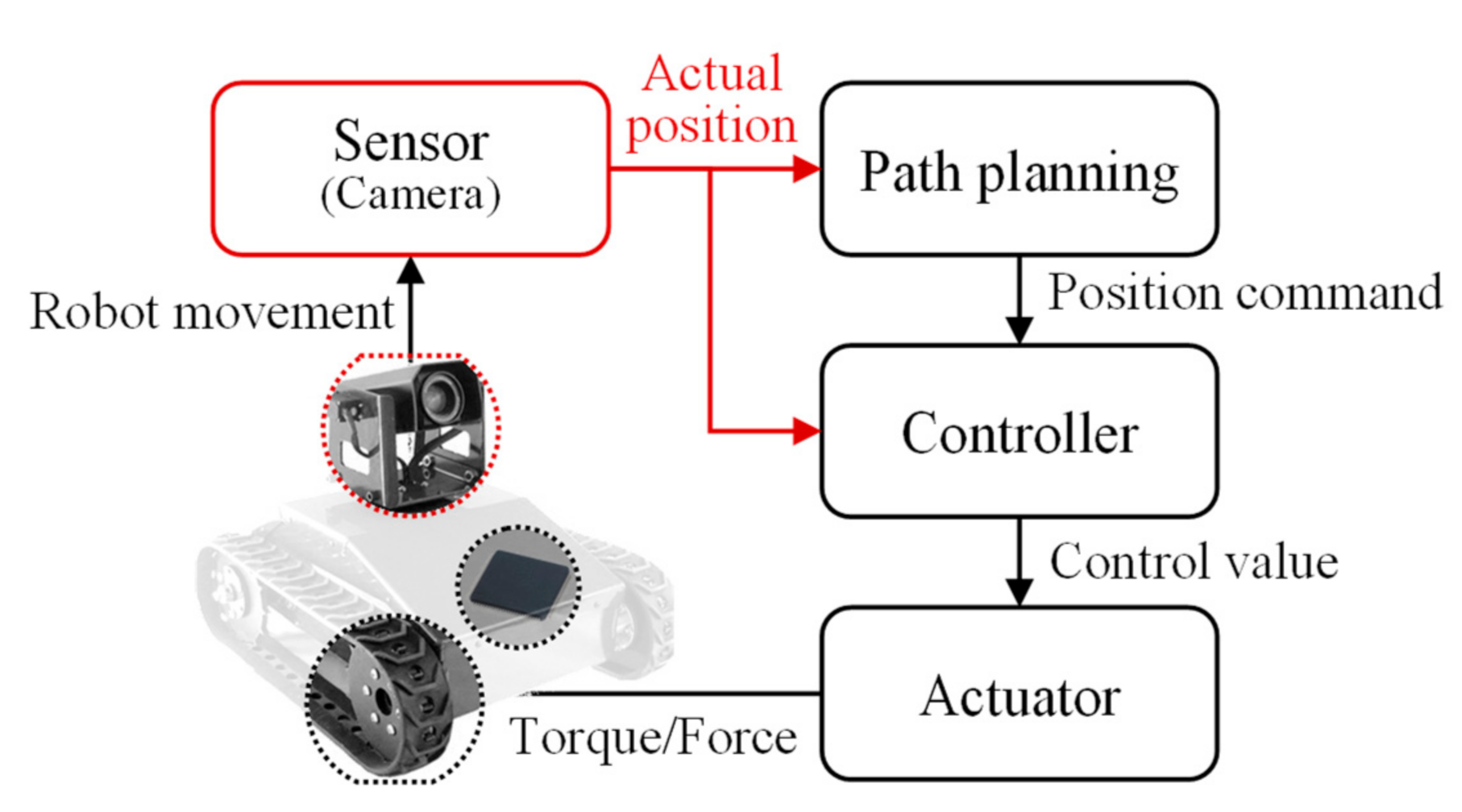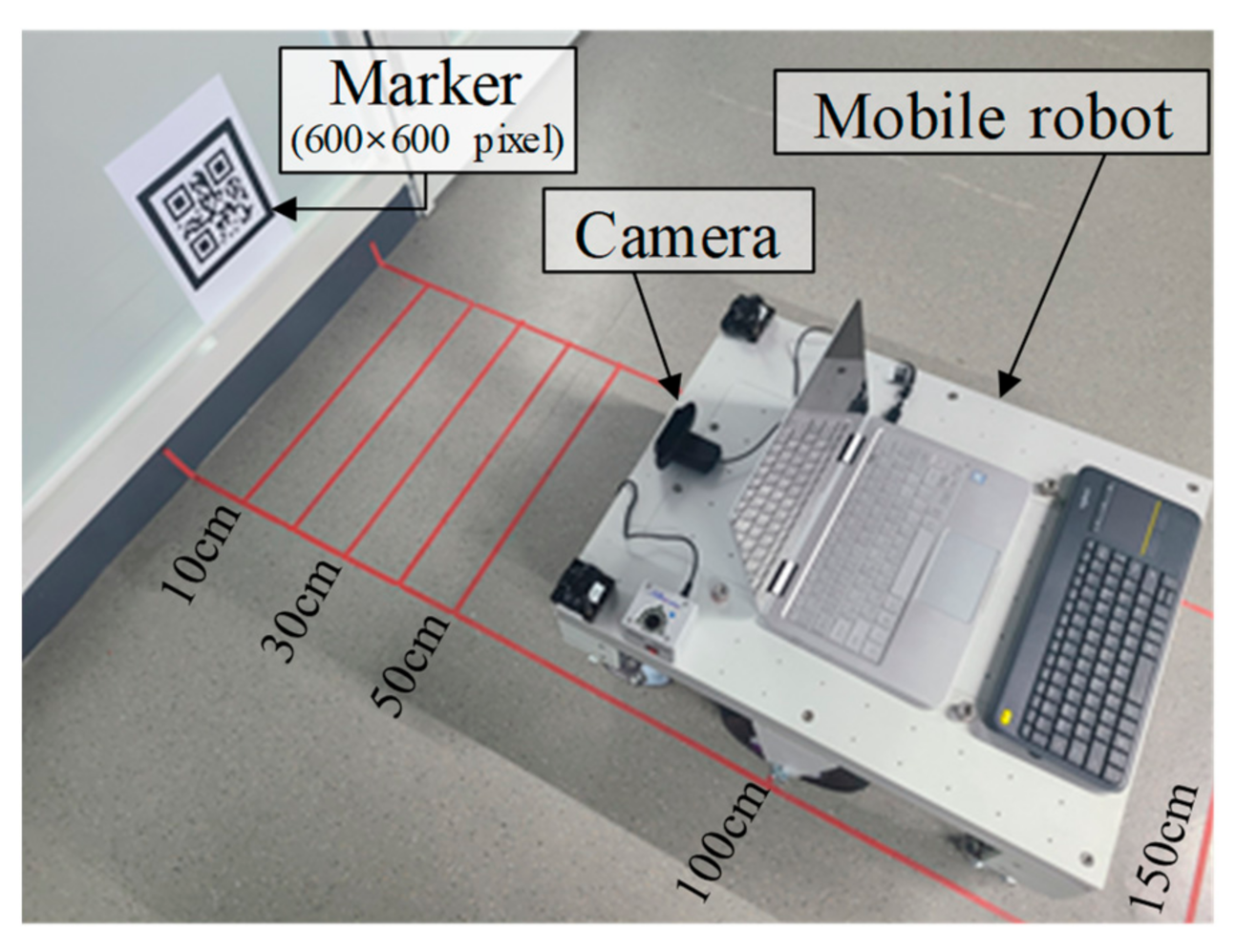Marker-Based Method for Recognition of Camera Position for Mobile Robots
Abstract
:1. Introduction
2. Proposed Strategy for Camera Position Recognition
2.1. Proposed Markers Considering the Movement of the Camera
2.1.1. Nested Marker
2.1.2. Hierarchical Marker
2.1.3. Characteristics of the Proposed Markers
- (1)
- A mixture of markers of different sizes or containing different included information may be used.
- (2)
- It does not need to update the internal parameters of the robot system even if the user frequently changes or adds to the identification information of the marker.
2.2. Estimating the Position of Unknown Markers
- Reference marker: A marker whose position is predefined or calculated in the global coordinate system.
- Representative marker: A marker for calculating the relative positions of markers in the local coordinate system.
- Unknown marker: A marker whose position information is unknown because it has been newly added or moved.
3. Verification of Proposed Method
3.1. Marker-Based Camera Position Recognition
3.2. Recognition Distance of the Proposed Markers
3.3. Position Recognition for Unknown Marker
4. Conclusions
Author Contributions
Funding
Institutional Review Board Statement
Informed Consent Statement
Data Availability Statement
Conflicts of Interest
References
- Patle, B.K.; Ganesh, B.L.; Anish, P.; Parhi, D.R.K.; Jagadeesh, A. A review: On path planning strategies for navigation of mobile robot. Def. Technol. 2019, 15, 582–606. [Google Scholar] [CrossRef]
- Park, B.S.; Yoo, S.J.; Park, J.B.; Choi, Y.H. A Simple Adaptive Control Approach for Trajectory Tracking of Electrically Driven Nonholonomic Mobile Robots. IEEE Trans. Control Syst. Technol. 2010, 18, 1199–1206. [Google Scholar] [CrossRef]
- Liang, X.; Wang, H.; Chen, W.; Guo, D.; Liu, T. Adaptive Image-Based Trajectory Tracking Control of Wheeled Mobile Robots with an Uncalibrated Fixed Camera. IEEE Trans. Control Syst. Technol. 2015, 23, 2266–2282. [Google Scholar] [CrossRef]
- Liang, X.; Wang, H.; Liu, Y.; Chen, W.; Liu, T. Formation Control of Nonholonomic Mobile Robots without Position and Velocity Measurements. IEEE Trans. Robot. 2018, 34, 434–446. [Google Scholar] [CrossRef]
- Liang, X.; Wang, H.; Liu, Y.; Chen, W.; Jing, Z. Image-Based Position Control of Mobile Robots with a Completely Unknown Fixed Camera. IEEE Trans. Autom. Control 2018, 63, 3016–3023. [Google Scholar] [CrossRef]
- Ali, M.A.H.; Mailah, M. Path Planning and Control of Mobile Robot in Road Environments Using Sensor Fusion and Active Force Control. IEEE Trans. Veh. Technol. 2019, 68, 2176–2195. [Google Scholar] [CrossRef]
- Jiang, J.; Di Franco, P.; Astolfi, A. Shared Control for the Kinematic and Dynamic Models of a Mobile Robot. IEEE Trans. Control Syst. Technol. 2016, 24, 2112–2124. [Google Scholar] [CrossRef] [Green Version]
- Zhang, K.; Chen, J.L.; Li, Y.; Gao, Y. Unified Visual Servoing Tracking and Regulation of Wheeled Mobile Robots with an Uncalibrated Camera. IEEE/ASME Trans. Mech. 2018, 23, 1728–1739. [Google Scholar] [CrossRef]
- Han, Y.J.; Park, T.H. Localization of a mobile robot using multiple ceiling lights. J. Inst. Control Robot. Syst. 2013, 19, 379–384. [Google Scholar] [CrossRef]
- Hofmann-Wellenhof, B.; Lichtenegger, H.; Colins, J. Global Positioning System: Theory and Practice, 5th ed.; Springer: Vienna, Austria, 2013. [Google Scholar]
- Wang, C.; Xing, L.; Tu, X. A Novel Position and Orientation Sensor for Indoor Navigation Based on Linear CCDs. Sensors 2020, 20, 748. [Google Scholar] [CrossRef] [PubMed] [Green Version]
- Mur-Artal, R.; Tardós, J.D. ORB-SLAM2: An Open-Source SLAM System for Monocular, Stereo, and RGB-D Cameras. IEEE Trans. Robot. 2017, 33, 1255–1262. [Google Scholar] [CrossRef] [Green Version]
- Gao, X.; Wang, R.; Demmel, N.; Cremers, D. LDSO: Direct sparse odometry with loop closure. In Proceedings of the 2018 IEEE/RSJ International Conference on Intelligent Robots and Systems (IROS), Madrid, Spain, 1–5 October 2018; pp. 2198–2204. [Google Scholar]
- Fiala, M. Designing Highly Reliable Fiducial Markers. IEEE Trans. Pattern Anal. Mach. Intell. 2009, 32, 1317–1324. [Google Scholar] [CrossRef] [PubMed]
- Kim, K.H.; Hwang, S.S. Autonomous UAV Landing System using Imagery Map and Marker Recognition. J. Inst. Control Robot. Syst. 2018, 24, 64–70. [Google Scholar] [CrossRef]
- Olson, E. AprilTag: A robust and flexible visual fiducial system. In Proceedings of the 2011 IEEE International Conference on Robotics and Automation, Shanghai, China, 9–13 May 2011; pp. 3400–3407. [Google Scholar]
- Heo, S.W.; Park, T.H. Localization System for AGVs Using Laser Scanner and Marker Sensor. J. Inst. Control Robot. Syst. 2017, 23, 866–872. [Google Scholar] [CrossRef]
- Mondéjar-Guerra, V.; Garrido-Jurado, S.; Muñoz-Salinas, R.; Marín-Jiménez, M.J.; Medina-Carnicer, R. Robust identification of fiducial markers in challenging conditions. Expert Syst. Appl. 2018, 336–345. [Google Scholar] [CrossRef]
- Romero-Ramirez, F.J.; Muñoz-Salinas, R.; Medina-Carnicer, R. Speeded up detection of squared fiducial markers. Image Vis. Comput. 2018, 76, 38–47. [Google Scholar] [CrossRef]
- Lee, E.H.; Lee, Y.; Choi, J.; Lee, S. Study of Marker Detection Performance on Deep Learning via Distortion and Rotation Augmentation of Training Data on Underwater Sonar Image. J. Korea Robot. Soc. 2019, 14, 14–21. [Google Scholar] [CrossRef]
- Cho, J.; Kang, S.S.; Kim, K.K. Object Recognition and Pose Estimation Based on Deep Learning for Visual Servoing. J. Korea Robot. Soc. 2019, 14, 1–7. [Google Scholar] [CrossRef]
- Lee, W.; Woo, W. Rectangular Marker Recognition using Embedded Context Information. In Proceedings of the Human Computer Interaction, Paphos, Cyprus, 2–6 September 2009; pp. 74–79. [Google Scholar]
- Depth Camera D435 – Intel® RealSense™ Depth and Tracking Cameras. Available online: https://www.intelrealsense.com/depth-camera-d435/ (accessed on 21 December 2020).
- Zheng, J.; Bi, S.; Cao, B.; Yang, D. Visual Localization of Inspection Robot Using Extended Kalman Filter and Aruco Markers. In Proceedings of the 2018 IEEE International Conference on Robotics and Biomimetics (ROBIO), Kuala Lumpur, Malaysia, 12–15 December 2018; pp. 742–747. [Google Scholar]
- Visp_ros – ROS Wiki. Available online: http://wiki.ros.org/visp_ros (accessed on 20 December 2020).
- Abdulla, A.A.; Liu, H.; Stoll, N.; Thurow, K. Multi-floor navigation method for mobile robot transportation based on StarGazer sensors in life science automation. In Proceedings of the 2015 IEEE International Instrumentation and Measurement Technology Conference (I2MTC) Proceedings, Pisa, Italy, 11–14 May 2015; pp. 428–433. [Google Scholar]
- Amsters, R.; Slaets, P. Turtlebot 3 as a Robotics Education Platform. In Proceedings of the International Conference on Robotics in Education (RiE), Sofia, Bulgaria, 26–28 April 2017; pp. 170–181. [Google Scholar]
















| Distance (cm) | 200 × 200 (pixels) | 600 × 600 (pixels) |
|---|---|---|
| 10 |  |  |
| 50 |  |  |
| 150 |  |  |
| Marker | Size of Information within Marker (Information) | Storage Location of Marker Information | Parameter Change When Marker Size Is Changed | |
|---|---|---|---|---|
| Coordinate | Size | |||
| AR | 5 bytes (ID) | Robot system | Robot system | Need |
| QR | About 2953 bytes | Marker | Robot system | Need |
| ArUco [24] | 5 bytes (ID) | Robot system | Robot system | Need |
| Proposed Marker | About 2953 bytes (ID, Size, Type) | Marker | Marker | Needless |
| Marker Size (pixel) | Distance (cm) | Previous Method (cm) | Proposed Method (cm) | ||
|---|---|---|---|---|---|
| 200 | 400 | 600 | |||
| 200 × 200 | 10 | 10.3 | 20.7 | 31.4 | 10.3 |
| 30 | 30.1 | 60.5 | 92.7 | 30.1 | |
| 50 | 50.3 | 100.6 | 154.1 | 50.0 | |
| 100 | Not recognized | ||||
| 150 | |||||
| 400 × 400 | 10 | Not recognized | |||
| 30 | 15.0 | 30.0 | 45.9 | 30.0 | |
| 50 | 25.1 | 50.4 | 77.1 | 50.3 | |
| 100 | 50.1 | 100.4 | 153.3 | 100.4 | |
| 150 | 73.6 | 151.2 | 228.3 | 150.1 | |
| 600 × 600 | 10 | Not recognized | |||
| 30 | 9.8 | 19.8 | 30.0 | 30.0 | |
| 50 | 16.4 | 32.8 | 50.1 | 50.1 | |
| 100 | 32.6 | 65.5 | 100.3 | 100.3 | |
| 150 | 49.2 | 98.3 | 150.2 | 150.2 | |
| Marker Number | Actual Position (x, y) | Estimated Position (x, y) |
|---|---|---|
| 0 | (0, 0) | (0, 0) |
| 1 | (180, 0) | (182.9, −1.2) |
| 2 | (0, 180) | (0.47, 180.2) |
| 3 | (180, 180) | (182.5, 178.4) |
| 4 | (0, 360) | (0.91, 363.8) |
| 5 | (180, 360) | (183.4, 362.9) |
| 6 | (0, 540) | (2.3, 544.0) |
| 7 | (180, 540) | (185.0, 542.2) |
| 8 | (0, 720) | (3.1, 725.9) |
| 9 | (180, 720) | (180.8, 726.7) |
| Marker Number | Actual Position (x, y) | Estimated Position (x, y) |
|---|---|---|
| 3 | (180, 180) | (180.4, 178.8) |
| ↓ | ||
| (0, 180) | (0.0, 180.2) | |
| 4 | (0, 360) | (0.9, 361.2) |
| ↓ | ||
| (180, 300) | (182.3, 299.2) | |
| Marker Number | Actual Position (x, y) | Estimated Position (x, y) | |
|---|---|---|---|
| 0 | Existing marker | (0, 0) | (0, 0) |
| 1 | (180, 0) | (181.8, 0.5) | |
| 2 | (0, 180) | (1.17, 180.1) | |
| 3 | (180, 180) | (180.4, 178.8) | |
| 4 | (0, 360) | (0.93, 361.2) | |
| 5 | (180, 360) | (180.3, 362.9) | |
| 6 | (0, 540) | (2.6, 541.8) | |
| 7 | (180, 540) | (182.2, 540.8) | |
| 8 | (0, 720) | (3.5, 723.5) | |
| 9 | (180, 720) | (182.1, 722.4) | |
| 10 | Added marker | (0, 900) | (4.54, 903.9) |
| 11 | (180, 900) | (185.8, 903.3) | |
Publisher’s Note: MDPI stays neutral with regard to jurisdictional claims in published maps and institutional affiliations. |
© 2021 by the authors. Licensee MDPI, Basel, Switzerland. This article is an open access article distributed under the terms and conditions of the Creative Commons Attribution (CC BY) license (http://creativecommons.org/licenses/by/4.0/).
Share and Cite
Gwak, D.-G.; Yang, K.-M.; Park, M.-R.; Hahm, J.; Koo, J.; Lee, J.; Seo, K.-H. Marker-Based Method for Recognition of Camera Position for Mobile Robots. Sensors 2021, 21, 1077. https://doi.org/10.3390/s21041077
Gwak D-G, Yang K-M, Park M-R, Hahm J, Koo J, Lee J, Seo K-H. Marker-Based Method for Recognition of Camera Position for Mobile Robots. Sensors. 2021; 21(4):1077. https://doi.org/10.3390/s21041077
Chicago/Turabian StyleGwak, Dong-Gi, Kyon-Mo Yang, Min-Ro Park, Jehun Hahm, Jaewan Koo, Joonwoo Lee, and Kap-Ho Seo. 2021. "Marker-Based Method for Recognition of Camera Position for Mobile Robots" Sensors 21, no. 4: 1077. https://doi.org/10.3390/s21041077
APA StyleGwak, D.-G., Yang, K.-M., Park, M.-R., Hahm, J., Koo, J., Lee, J., & Seo, K.-H. (2021). Marker-Based Method for Recognition of Camera Position for Mobile Robots. Sensors, 21(4), 1077. https://doi.org/10.3390/s21041077






